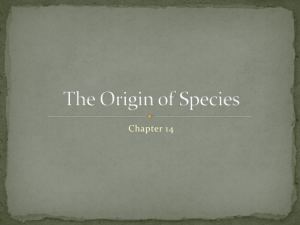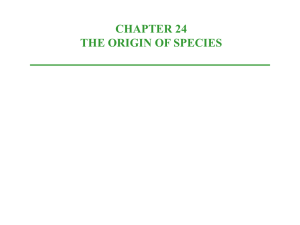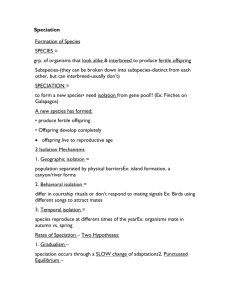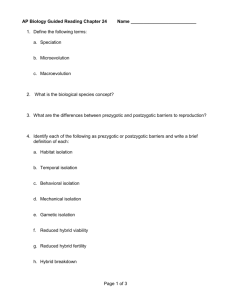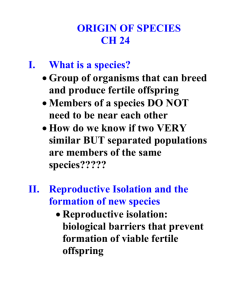Chapter 24 Origin of Species
advertisement
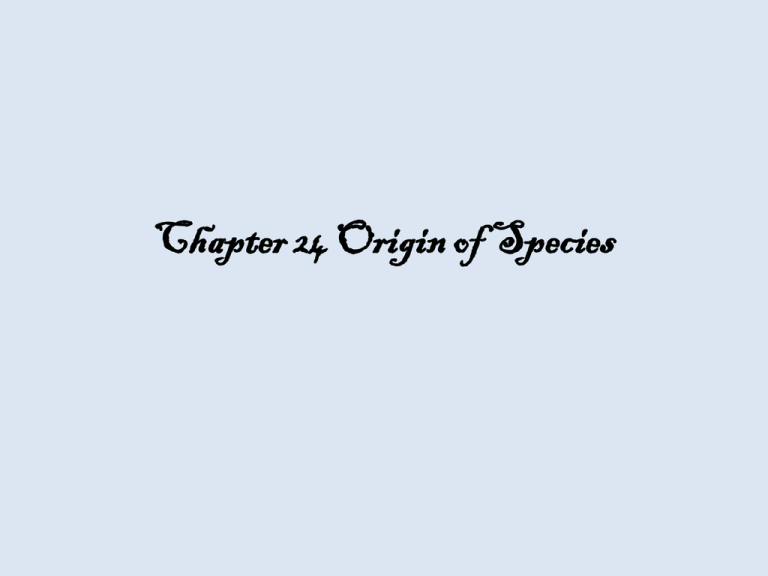
Chapter 24 Origin of Species Mystery of Mysteries • Speciation - origin of new species focal point of evolution new species is source of biological diversity • Macroevolution – evolutionary change beyond a single species • Two patterns of evolutionary change: Anagenesis – (phyletic) accumulation of changes that gradually transform a given species into a species with different characteristics Cladogenesis – (branching) splitting of the gene pool into two or more, giving rise to new species Biological Species Concept • Biological Species concept – defines a species as a population whose members have the potential to interbreed and produces viable, fertile offspring - Cannot produce viable, fertile offspring with members of other populations - emphasizes separateness of species from one another due to reproductive barriers • Reproductive isolation – biological factors (barriers) that impede members of two species from producing viable fertile hybrids Reproductive Isolation Reproductive Isolation • Prezygotic barriers – impede or hinder fertilization if mating occurs a. Habitat isolation – two species that occupy different habitats in the same area; rarely interact b. Temporal isolation – species that breed during different day, season, or year cannot mix gametes c. Behavioral isolation – courtship rituals or other unique mating behaviors d. Mechanical isolation – morphological differences prevent successful mating e. Gametic isolation – sperm of one species may not be able to fertilize eggs of another species West vs. East Behavioral isolation Reproductive Isolation • Postzygotic barriers – prevent a hybrid from developing into viable, fertile adult a. Reduced hybrid viability – genes from different parents impair hybrids development b. Reduced hybrid fertility – hybrid may be healthy and vigorous but sterile. Chromosome differences from two parents; meiosis will fail to produce normal gametes c. Hybrid breakdown – first generation is viable and fertile, but next generation is impaired and possibly sterile Other Species Distinctions • Morphological species concept – characterizes by body, shape, size, and structural features • Palentological species concept – morphological features of discrete species known only from fossil record • Ecological species concept – views species in terms of ecological niche or role in community • Phylogenetic species concept – species as a set of organisms with unique genetic history Geographic Isolation • Allopatric speciation – gene flow is interrupted when a population is divided into geographically isolated subpopulations Ex: rise and fall of lake water levels - can occur when descendents are isolated from parent population - barrier of separation depends on organisms mobility Ex: hawk or windblown pollen compared to squirrels or mice * true allopatric speciation would mean that populations could not interbreed successfully Sympatric Speciation • Sympatric speciation – speciation takes place in geographically overlapping populations - chromosomal changes and nonrandom mating reduces gene flow • Extra sets of chromosomes or polyploidy gives rise to an autopolyploid- more than two sets of chromosomes from a single species - likely result of failures in cell division - offspring are normally sterile, unless that can mate with other autopolyploids (same # - tetraploids) - Allopolyploid – a sterile hybrid that asexually propagates and becomes a fertile polyploid- new species Ex: oats, wheat, cotton, potatoes, and tobacco all are polyploids Sympatric Speciation • Polyploid speciation can happen in animals depending on habitat conditions and sexual selection Ex: Apple maggot fly whose habitat changed from hawthorne to apple trees *Also, cichlid fish in Lake Victoria of eastern Africa, nonrandom mating or selecting on coloration Adaptive Radiation • Adaptive radiation – evolution of many diversely adapted species from a common ancestor after being introduced into new environmental opportunities and challenges - organisms make way to new, distant habitats, or when extinctions occur opens niches for survivors Ex: inhabitats of Hawaiian islands Punctuated Equilibrium • Punctuated equilibrium – episodes in fossil record where a new species suddenly appeared, persisted unchanged, and then disappear - Time period of the fossil record skews the perception of changes that occurred making them unnoticeable - External anatomy may not give best interpretation of adaptive changes that occurred in species Accumulation of Speciation Events • Speciation can result from seemingly small events, but through continued divergence, differences accumulate - forms basis of macroevolutionary change - processes that facilitate the change are natural selection, mutation, genetic drift, and gene flow - accumulation of small speciation episodes accounts for sweeping evolutionary changes Ex: previous and present function of the eye - exaptations – structures that evolve in one context but become co-opted for another function Ex: honeycombed bones and feathers in birds Genes that Control Development • Heterochrony – evolutionary change in the rate and timing of developmental events • Allometric growth – proportioning that helps give a body its specific form *changing rates slightly can substantially change adult form Ex: salamander feet Controlling Development • Timing of Reproductive development of somatic organs can also be altered by heterochrony • Paedomorphosis – reproductive development accelerates compared to somatic development making the body retain juvenile body parts during sexual maturity *contrasts ancestral species in which juvenile appearance is actually adult stage Changes in Spatial Pattern • Homeotic genes – control the placement and spatial organization of body parts Ex: Hox genes that determine positional information in animal embryos - changes or mutations can dramatically impact morphology Species Selection • Branching evolution can result in an evolutionary trend even if some new species counter the trend • Species selection states that species that endure the longest and generate the most offspring determine the direction of the major trends • Appearances of trends does not imply some intrinsic drive toward a particular phenotype • Evolution is the result of interactions between organisms and their environments • If environmental conditions change, those trends may stop or be reversed Hybrid Zones Hybrid zone – region in which members of different species meet, mate, and produce offspring of mixed ancestry Over time 3 outcomes possible: 1. Reinforcement of reproductive barriers 2. Fusion or weakening of barriers to a single species 3. Stability or continued production of hybrids even when selected against
